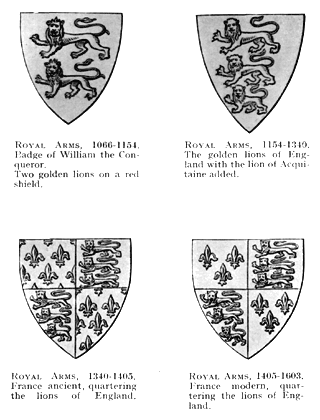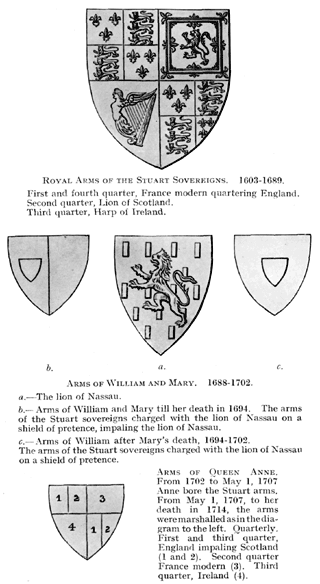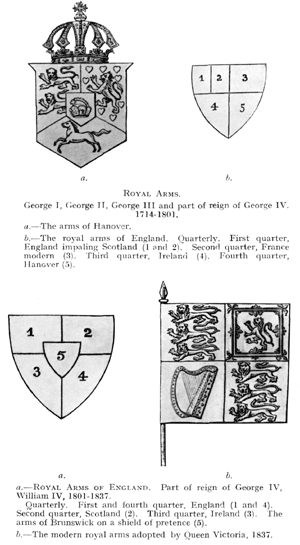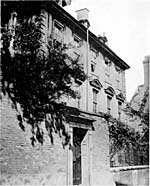The development of the royal arms of England is interesting (Figs. 9-11), and of use for dating purposes. Although heraldry was not systematised till the twelfth century, badges were used for warlike purposes long before that time. William the Conqueror's badge was two golden lions "passant gardent" on a red shield, and this badge was also used by Rufus, Henry I and Stephen. Henry II was Lord of Acquitaine and the badge of Acquitaine was a single golden lion on a red shield. Henry II added this lion to his paternal shield and so we get the three golden lions of England still borne by King George VI. In 1336, Edward III claimed the throne of France, and to emphasize this claim quartered the arms of France, a "powdering" of silver lilies on a blue shield, with those of England. As France was then regarded as the more important country, its arms were set in the chief quarter of the shield, the upper dexter quarter. In 1405, during the reign of Henry IV, the arms of France were changed from a powdering of silver lilies to three silver lilies on a blue shield, and this change was followed in the English arms. After his accession in 1603, James I added the lion rampant of Scotland and the Stuart shield was divided into quarters. In the first and fourth quarter were the arms of France and England, quartered, in the second quarter was the lion of Scotland, and in the third quarter the harp of Ireland. This remained the royal shield until the times of William and Mary who added the arms of Nassau, a lion rampant on a billetted ground on a "shield of pretence" before the arms of England. On May 1st, 1707, the arms were remarshalled for Queen Anne and became, first and fourth quarter, France and England impaled, i.e. side by side and not quartered, second quarter, the lion of Scotland, third quarter, the harp of Ireland. With the accession of George I in 1714 the arms of Hanover, of which the most prominent feature is the white running Horse of Westphalia, were substituted for those of England in the fourth quarter of the English shield, and these arms remained in use till 1801 when all claim to the crown of France was dropped and the French arms were taken out of the royal shield which became, first and fourth quarter, the lions of England, second quarter, the lion of Scotland, third quarter, the harp of Ireland, on a shield of presence, the arms of Hanover. The present arms were adopted by Queen Victoria.
 |
 |
Fig. 9. |
Fig. 10. |
 |
Fig. 11. |
The shield over the east door in the north aisle bears the arms of Queen Anne and dates from about 1707, while its western neighbour carries those of George I and was made about 1714. It is not without interest to note that in the church accounts of Edwalton, under the year 1772, there is a record that 5/- was paid to a certain Mr. Turton for a "frame of arms" which no doubt refers to a blazon of royal arms similar to these in St. Nicholas' Church.
Hanging on the south wall of the west gallery is an exceedingly interesting hatchment whose date is obscure, but it may well be about 1690-1700. Hatchments are of value for genealogical purposes, and we have seen how they were placed outside the residence of the deceased and, after a time, transferred to the safe custody of the church. They were usually diamond-shaped frames, and their significance varied. For a bachelor his arms, or his paternal arms, were displayed on a black ground. An unmarried lady showed her father's arms on a black ground surrounded by a loosely knotted golden cord issuing from the top. In the case of a husband, the shield was divided into halves and the husband's arms were shown on the dexter half on a black ground while those of his wife were on a white ground on the sinister side. A wife's hatchment was the same as a husband's except that her arms were shown on a black ground while her surviving husband's arms were on a white ground. The presence of a skull and cross-bones denotes the last of a family.1
This hatchment in St. Nicholas' shows the three golden lions' paws of the Newdigates on the dexter, or husband's side of the shield impaling the arms of Hotoft of Flintham, and below is a skull and cross-bones. This shows that a Newdigate married a Hotoft and that at his death his branch of the family became extinct. The Newdigates were a wealthy and influential family in Nottingham at the end of the seventeenth century and the beginning of the eighteenth century, and little is known about them. One of the family built Newdigate House in Castle Gate about 1680 (Fig. 12), and it seems possible that this hatchment commemorates his death, for we know that Marshal Tallard went into residence at Newdigate House soon after his defeat and capture at Blenheim in 1704. Had there been a Newdigate heir it seems unlikely that the house would have been available for the marshal.

Fig. 12. Newdigate House, 64, Castle Gate, Nottingham. Built by a member of the Newdigate family about. 1680. Possibly he is commemorated by the hatchment preserved in St. Nicholas Church.
There are many memorials in the church but by far the most interesting, though by no means the most spectacular, are the Collin tombs which will be found on the floor of the south transept. Laurence Collin was born, probably in Peterborough, in 1614 and was a gunner in Nottingham Castle during the civil war. On the cessation of hostilities he resumed his trade as a wool-comber, and after some difficulties owing to the fact that he was not a freeman of the town, he settled in Nottingham and prospered exceedingly. He built the charming house with its moulded brickwork and its date-stone L.A.C. 1664 (Laurence and Anne Collin) which may be seen from the passage No. 39 Castle Gate (Fig. 4) and laid the foundations of the family fortune. He died in 1704 at the age of 91. He had a large family of which the most interesting member was his son Abel, who was born in 1653. Abel Collin was a mercer who accumulated a fortune but remained a bachelor until his death in 1705. He lies buried beside his father, and it is interesting to know that his tombstone, including the lettering, cost £215s. 0d.2 In his lifetime he was extraordinarily benevolent, and by his will he left money for the foundation of the Collin Charity which, in the hands of generations of capable administrators, has wrought so much good during the last couple of hundred years.
1 H. Gill, Village Church in the Olden Times, p. 56.
2 History of Collin's Charity, p. 40.
